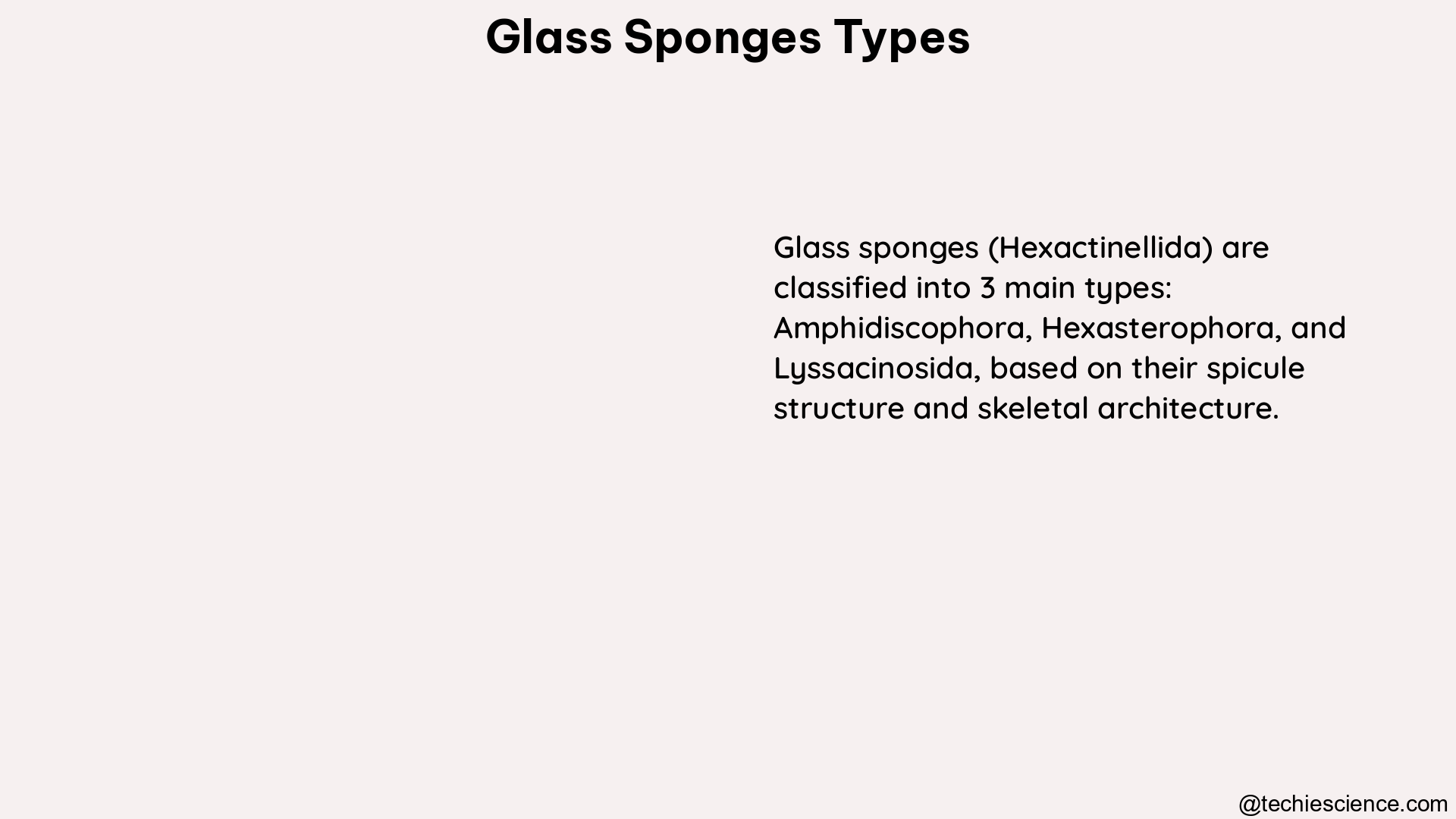Glass sponges, also known as Hexactinellida, are a unique and fascinating group of marine invertebrates that have captured the attention of scientists and nature enthusiasts alike. These deep-sea dwellers are renowned for their intricate, glass-like skeletal structures, which serve as a testament to the remarkable adaptations and evolutionary strategies of these remarkable creatures.
Understanding the Diversity of Glass Sponges
Glass sponges are a class within the phylum Porifera, which includes over 8,000 known species of sponges. The Hexactinellida class, or glass sponges, is further divided into three orders: Amphidiscosida, Hexactinosida, and Lyssacinosida. Each of these orders exhibits distinct morphological and ecological characteristics, contributing to the overall diversity of glass sponges.
Amphidiscosida
The Amphidiscosida order is characterized by the presence of amphidiscs, which are spicules (skeletal elements) with a central shaft and two terminal discs. These spicules provide structural support and protection for the sponge. Amphidiscosid glass sponges are typically found in shallow to deep-water environments, with some species inhabiting the deep-sea floor.
Hexactinosida
The Hexactinosida order is known for its highly complex and intricate skeletal structures, which are composed of six-rayed spicules (hexactines). These spicules form a three-dimensional lattice-like framework that provides strength and support to the sponge’s body. Hexactinosid glass sponges are primarily found in deep-sea habitats, often in areas with strong currents or near hydrothermal vents.
Lyssacinosida
The Lyssacinosida order is characterized by the presence of loose, unorganized spicules that are not fused into a rigid skeletal structure. Instead, the spicules are held together by a soft, gelatinous tissue. Lyssacinosid glass sponges are typically found in deep-sea environments, where they may play a crucial role in the ecosystem by providing habitat and food for other marine organisms.
Ecological Significance of Glass Sponges

Glass sponges are not only visually stunning, but they also play a vital role in the deep-sea ecosystems they inhabit. Here are some key facts about the ecological significance of these remarkable creatures:
Habitat Provision
Glass sponge reefs, found in the Salish Sea off the coast of British Columbia, Canada, provide a complex and diverse habitat for a wide range of marine organisms. These reefs support over 115 unique taxonomic groups, including invertebrates and fish, making them hotspots of biodiversity in the deep ocean.
Water Filtration
Glass sponges are highly efficient filter feeders, capable of processing vast volumes of seawater. A study in the Salish Sea found that individual glass sponge reefs can filter between 0.2 and 17.5% of the live reef-building sponge cover, collectively filtering an astounding 1.04 × 10^12 liters of water per day. This filtration process removes up to 1 gram of carbon per square meter per day, playing a crucial role in the cycling of nutrients and the maintenance of water quality in deep-sea environments.
Carbon Sequestration
Glass sponges are known to be effective at sequestering carbon, which is an important process in mitigating the effects of climate change. The silica-based skeletal structures of these sponges can act as a long-term sink for carbon, removing it from the active carbon cycle and storing it in the deep ocean for extended periods.
Habitat Requirements
Glass sponges have specific habitat requirements that contribute to their distribution and abundance. Studies have shown that they are more abundant in areas with complex seabed terrain, such as seafloor rugosity (roughness), curvature, and depth. These factors likely provide the necessary conditions for the sponges to thrive, including access to food, protection from predators, and suitable substrate for attachment.
Threats and Conservation Efforts
Despite their ecological importance, glass sponges face various threats, primarily from human activities. Deep-water populations of non-reef forming glass sponges in Antarctica and the North Atlantic have been found to play an essential role in deep-sea ecosystems, but they are threatened by trawl fisheries, which can physically damage or destroy these fragile habitats.
To address these threats, conservation efforts have been undertaken in various regions. In Canada, for example, the Hecate Strait and Queen Charlotte Sound Glass Sponge Reefs Marine Protected Area was established in 2017 to protect the unique glass sponge reefs found in the Salish Sea. This protected area aims to safeguard the biodiversity and ecosystem services provided by these remarkable sponges.
Conclusion
Glass sponges are truly remarkable creatures, with their intricate skeletal structures, diverse ecological roles, and unique adaptations to the deep-sea environment. As we continue to explore and understand these fascinating organisms, it is crucial that we work to protect and conserve their habitats, ensuring that these remarkable sponges can continue to thrive and contribute to the rich tapestry of life in the world’s oceans.
References:
- Kahn, A. S., Ruhl, H. A., & Smith, K. L. (2012). Temporal changes in deep-sea sponge populations are correlated with ocean climate variability. Deep Sea Research Part I: Oceanographic Research Papers, 70, 36-41.
- Kahn, A. S., Yahel, G., Chu, J. W., Tunnicliffe, V., & Leys, S. P. (2015). Benthic grazing and carbon sequestration by deep-water glass sponge reefs. Limnology and Oceanography, 60(1), 78-88.
- Leys, S. P., Mackie, G. O., & Reiswig, H. M. (2007). The biology of glass sponges. Advances in Marine Biology, 52, 1-145.
- Maldonado, M., Aguilar, R., Bannister, R. J., Bell, J. J., Conway, K. W., Dayton, P. K., … & Young, C. M. (2017). Sponge grounds as key marine habitats: a synthetic review of types, structure, functional roles, and conservation concerns. Marine Animal Forests, 145-183.
- Reiswig, H. M. (1971). Particle feeding in natural populations of three marine demosponges. The Biological Bulletin, 141(3), 568-591.

Hi….I am Anushree Verma, I have completed my Master’s in Biotechnology. I am a very confident, dedicated and enthusiastic author from the biotechnology field. I have a good understanding of life sciences and great command over communication skills. I thrive to learn new things every day. I would like to thank this esteemed organization for giving me such a great opportunity.
Let’s connect through LinkedIn- https://www.linkedin.com/in/anushree-verma-066ba7153